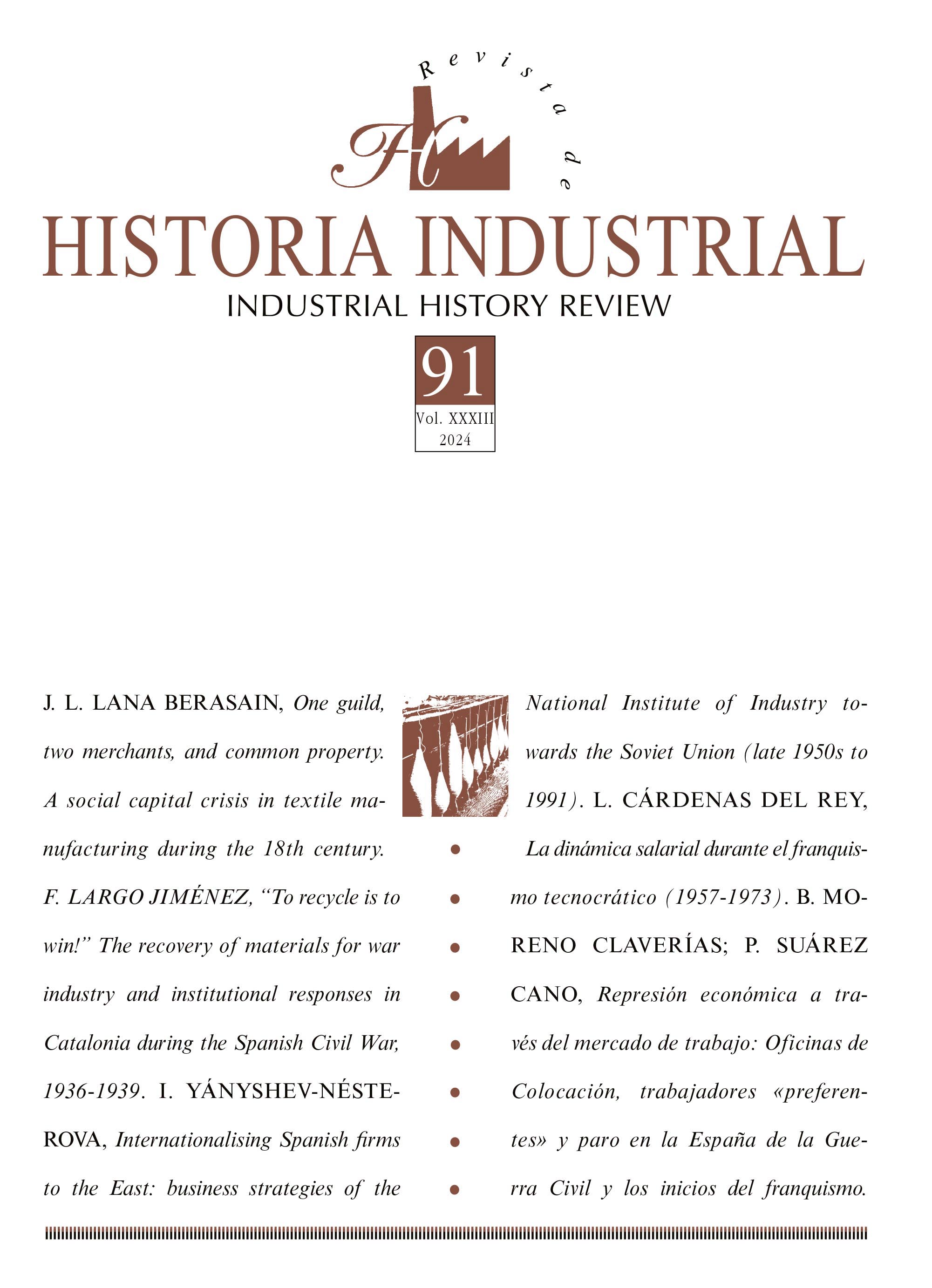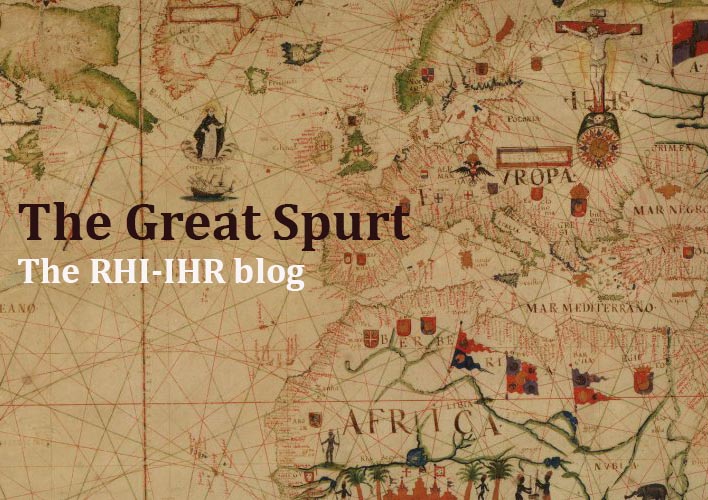One guild, two merchants, and common property. A social capital crisis in textile manufacturing during the 18th century
DOI:
https://doi.org/10.1344/rhiihr.41898Keywords:
Estella-Lizarra, guild, factory, social capital, commercial capital, textile manufacturingAbstract
A case study of the wool carders’ guild in Estella-Lizarra (Navarre) from the 16th to 19th centuries questions prevalent opinions among historians, which have tended to define these collective action institutions as monopolies. This study complements the traditional “outside-in” approach that considers the guild to be a monolithic agent, adopting an inside perspective that reveals tensions between collective and individual interests. The research focuses on the collective management of common properties (fulling-mill and dyeing house) until their disappearance in 1758, and guild relations with commercial capital in the form of a major financial sponsor and a new factory. Difficulties associated with the guild’s financial management and the loss of its social capital lay at the heart of its troubles
Downloads
References
Azcona Guerra, Ana. 1996. Comercio y comerciantes en la Navarra del siglo XVIII. Pamplona: Regional Government of Navarre.
Bavel, Bas van. 2022. ‘Wealth inequality in pre-industrial Europe: What role did associational organizations have?’, Economic History Review, 75 (3): 643-666.
Becattini, Giacomo. 2002. ‘Del distrito industrial marshalliano a la teoría del distrito contemporánea. Una breve reconstrucción crítica’, Investigaciones Regionales, 1: 9-32.
Bielza de Ory, Vicente. 1968. ‘Estella. Estudio geográfico de una pequeña ciudad navarra’, Príncipe de Viana, 29 (110-111): 53-115.
Calderón Berrocal, M. Carmen, and Emilio M. Romero Macías. 2010. ‘Génesis y competencia de las Juntas de Comercio, Moneda y Minas’, De Re Metallica, 14: 61-69.
Caracausi, Andrea, Matthew Davies, and Luca Mocarelli. 2018. Between regulation and freedom: Work and manufactures in European cities, 14th-18th centuries. Cambridge: Cambridge Scholar Publishing.
Epstein, Stephen R. et al. 1998. Guilds, economy and society. B1. Proceedings Twelfth International Economic History Congress. Seville: Universidad de Sevilla.
Epstein, Stephen R. 1998. ‘Craft guilds, apprenticeship, and technological change in preindustrial Europe’, The Journal of Economic History, 58 (3): 684-713.
Epstein, Stephen R. 2009. ‘Craft guilds in the pre-modern economy: A discussion’, Economic History Review, 16 (1): 155-174.
Epstein, Stephen R., and Maarten Prak. 2008. Guilds, innovation and the European economy, 1400-1800. Cambridge: Cambridge University Press.
Fazzini, Mauro. 2022. ‘El retorno gremial: un análisis crítico’, Anales de Historia Antigua, Medieval y Moderna, 56 (1): pp. 57-78
Ferrer-Alós, Llorenç. 2022. ‘El gremio cuando interesa. Producción y comercialización de pañuelos de seda en Manresa (Cataluña) en el siglo XVIII’, Studia Histórica: Historia Moderna, 44 (1), pp. 409-444.
Field, John. 2003. Social Capital. London: Routledge.
Gallego, Domingo. 2022. Los caminos del progreso. Granada: Comares.
González Arce, José D. 2008. ‘Asociacionismo, gremios y restricciones corporativas en la España medieval, siglos XIII-XV’, Investigaciones de Historia Económica, 10: pp. 9-34.
González Enciso, Agustín. 1998. ‘Los gremios y el crecimiento económico’. Memoria y Civilización, 1: 111-137.
Greif, Avner. 2006. Institutions and the path to the modern economy: lessons from medieval trade. Cambridge: Cambridge University Press.
Hanifan, Lyda J. 1916. The Rural School Community Centre. Annals of the American Academy of Political and Social Sciences, 67, 130-138.
Hernández García, Ricardo, and José D. González Arce. 2015. ‘Gremios y corporaciones laborales. Debates historiográficos y estado de la cuestión’, Áreas, 34: 7-18.
Idoate, Florencio. 1966. Rincones de la historia de Navarra. Pamplona: Institución Príncipe de Viana.
Kula, Witold. 1976. Teoría económica del sistema feudal [Economic Theory of the Feudal System]. Buenos Aires: Siglo XXI.
Laborda-Pemán, Miguel. 2017. ‘Beyond Markets and Hierarchies in Pre-industrial Europe’. PhD Thesis, Utrecht: University of Utrecht.
Lana Berasain, José-Miguel. 2022. La ciudad industrial. La manufactura estellesa al final del Antiguo Régimen. Terra Stellae, 13: 8-33.
López, Victoria, and José A. Nieto, eds. 1996. El trabajo en la encrucijada. Artesanos urbanos en la Europa de la Edad Moderna. Madrid: Los Libros de la Catarata.
Lucassen, Jan, Tine De Moor, and Jan Luiten van Zanden. 2008. ‘The Return of the Guilds: Towards a Global History of the Guilds in Pre-industrial Times’, International Review of Social History, 53 (supplement 16): 5-18.
Mateos Royo, José A. 2001. ‘Municipal councils and corporate protectionism: town councils and guilds in the kingdom of Aragon during the sixteenth and seventeenth centuries’. In Labour and labour markets between town and countryside (Middle Ages-19th century), edited by Bruno Blondé, Eric Vanhaute, and Michèle Galand, 178-197. Turnhout: Brepols.
Monsalvo, José María. 2001. ‘Los artesanos y la política en la Castilla medieval. Hipótesis acerca de la ausencia de las corporaciones de oficio de las instituciones de gobierno urbano’. In Historia social y ciencias sociales, edited by Santiago Castillo, and Roberto Fernández, 291-319. Lleida: Milenio.
Nieto Sánchez, José A. 2022. ‘A propósito del monopolio gremial: Toledo, 1700-1837’. Investigaciones de Historia Económica, 18 (1): 12-25.
Nieto Sánchez, José A., and Juan Carlos Zofío Llorente. 2015. ‘Los gremios de Madrid durante la edad moderna: una revisión’, Areas, 34: 47-61.
North, Douglass C. 1993. Instituciones, cambio institucional y desempeño económico [Institutions, Institutional Change and Economic Performance]. Mexico: Fondo de Cultura Económica.
North, Douglass C., John J. Wallis, and Barry R Weingast. 2013. Violence and social orders. New York: Cambridge University Press.
Ogilvie, Sheilagh, & Carus, A. W. 2014. ‘Institutions and Economic Growth in Historical Perspective’. In Handbook of Economic Growth, edited by Philippe Aghion, and Steven N. Durlauf, vol. 2A, 403-513. Amsterdam: Elsevier.
Ogilvie, Sheilagh. 2004. ‘Guilds, efficiency, and social capital: Evidence from German proto-industry’. Economic History Review, 57 (2): 286-333.
Ogilvie, Sheilagh. 2007. ‘Whatever is, is right? Economic institutions in pre-industrial Europe’, Economic History Review, 60 (4): 649-684
Ogilvie, Sheilagh. 2014. ‘The economics of guilds’. Journal of Economic Perspectives, 28 (4): 169-192.
Ogilvie, Sheilagh. 2019. The European Guilds. An economic analysis. Princeton – Oxford: Princeton University Press.
Olson, Mancur. 1992. La lógica de la acción colectiva [The logic of collective action]. Mexico City: Editorial Limusa.
Ordinances. 1563. Ordenanzas generales del Reyno de Navarra sobre el obrar paños, bonetes, sombreros y burullería. Estella: Adrián de Anvers. Biblioteca Digital de Navarra – Digital Library of Navarre: https://binadi.navarra.es/registro/00008166
Ordinances. 1592. Ordenanzas generales del Reyno de Navarra sobre el obrar paños y burullería. Pamplona: Pedro Porralis. Biblioteca Digital de Navarra - Digital Library of Navarre: https://binadi.navarra.es/registro/00008305
Ostrom, Elinor (2011). El gobierno de los bienes comunes. La evolución de las instituciones de acción colectiva [Governing the Commons: The Evolution of Institutions for Collective Action] Mexico: Fondo de Cultura Económica.
Ostrom, Elinor, & Ahn, T. K. 2003. ‘Una perspectiva del capital social desde las ciencias sociales: capital social y acción colectiva’ [A Social Science Perspective on Social Capital: Social Capital and Collective Action]. Revista Mexicana de Sociología, 65 (1): 155-233.
Pérez Sarrión, Guillermo. 1975. El Canal Imperial y la navegación hasta 1812. Zaragoza: Institución Fernando el Católico.
Prak, Maarten, Catherina Lis, Jan Lucassen, and Hugo Soly, eds. 2000. Craft Guilds in the Early Modern Low Countries. London: Ashgate.
Prak, Maarten, et al. 2020. ‘Access to the trade: monopoly and mobility in European craft guilds in the seventeenth and eighteenth centuries’, Journal of Social History, 54 (2): 421-452
Prak, Maarten, and Patrick Wallis, eds. 2020. Apprenticeship in Early Modern Europe. Cambridge: Cambridge University Press.
Putnam, Robert D., and Kristin A. Goss. 2003. ‘Introducción’. In El declive del capital social, Ed. R. Putnam, 7-33. Barcelona: Galaxia Gutenberg / Círculo de Lectores.
RAH (Spain’s Royal Academy of History). 2003 [1802]. Diccionario geográfico-histórico de España. Comprehende el Reyno de Navarra, Señorío de Vizcaya y provincias de Álava y Guipúzcoa. Valladolid: Editorial Maxtor.
Richardson, Gary. 2001. ‘A Tale of Two Theories: Monopolies and Craft Guilds in Medieval England and Modern Imagination’, Journal of the History of Economic Thought, 23 (2): 217-242.
Romero-Marín, Juanjo. 2015. ‘Eficiencia, ¿qué eficiencia? Gremios y desarrollo urbano en Barcelona, 1814-1855’. Áreas, 34: 93-103.
Smith, Adam. 2007/1776. La riqueza de las naciones [The Wealth of Nations]. Madrid: Alianza.
Sola Parera, A. (Ed.). 2019. Artesanos, gremios y género en el sur de Europa (siglos XVI-XIX). Barcelona: Icaria.
Soly, Hugo. 2008. ‘The Political Economy of European Craft Guilds’, International Review of Social History, 53 (supplement 16): 45-71.
Sorauren, Mikel. 1984. ‘Navarra, ¿Revolución industrial frustrada?’, Langaiak, 5: 21-40.
Torras, Jaume. 1981. ‘Estructura de la industria pre-capitalista. La draperia’, Recerques: Historia, economía i cultura, 11: 7-28.
Torró Gil, Lluís. 2004. ‘Procedimientos técnicos y conflictividad gremial: el ancho de los peines de los telares alcoyanos (1590-1797)’, Revista de Historia Industrial, 12 (25): 165-181.
Vázquez de Prada, Valentín, et al. 1993. Las Cortes de Navarra desde su incorporación a la Corona de Castilla. Tres siglos de actividad legislativa. Pamplona: EUNSA.
Downloads
Published
How to Cite
Issue
Section
License
Copyright (c) 2023 Revista de Historia Industrial — Industrial History Review

This work is licensed under a Creative Commons Attribution 4.0 International License.
The author assigns all rights to the publisher. Creative Commons
The author who publishes in this journal agrees to the following terms:
- The author assigns all intellectual property rights exclusively to the publisher for the entire duration of the applicable intellectual property rights.
- The publisher will distribute the texts under the Creative Commons Attribution License, which allows others to share the work, provided that they acknowledge the authorship, its initial publication in this journal, and the conditions of the license.





